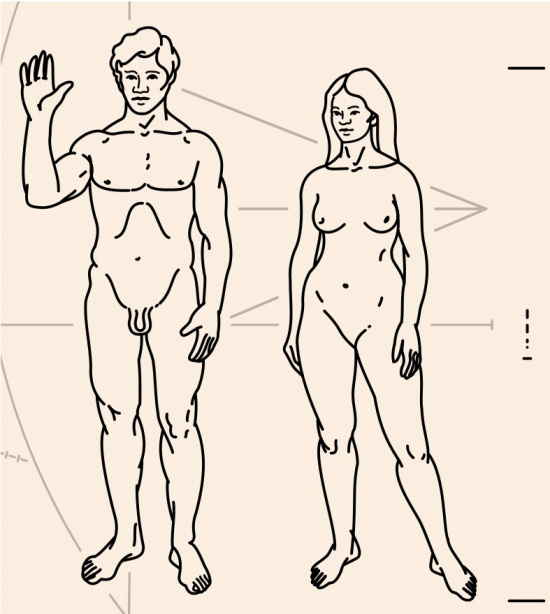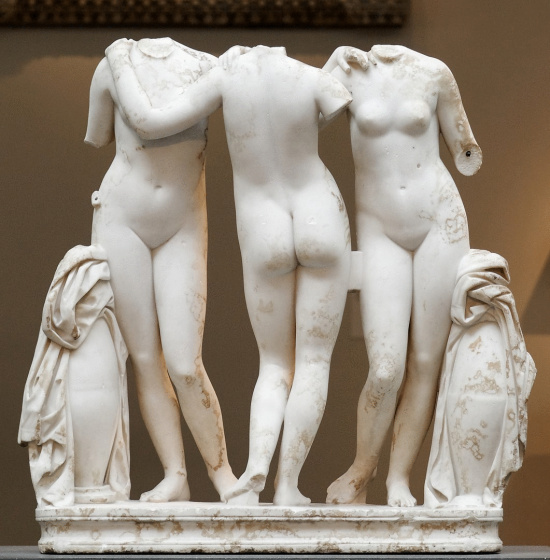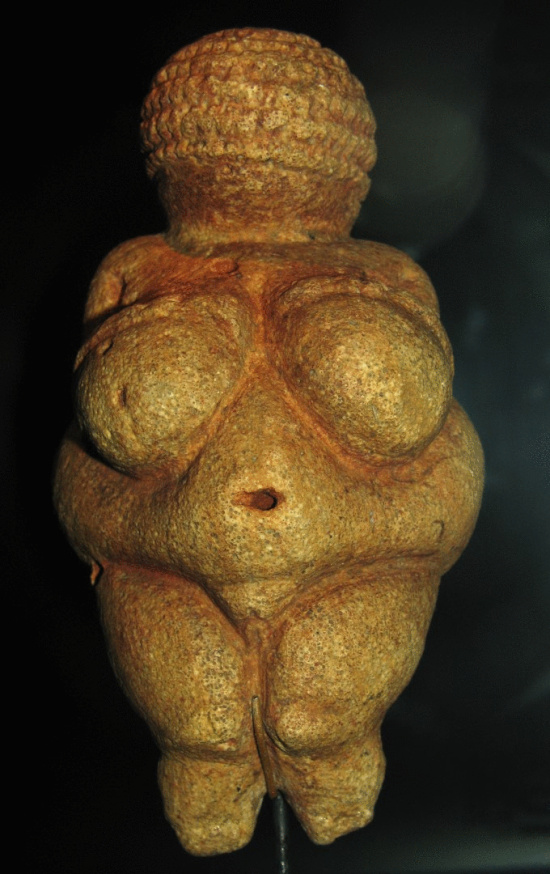Of Carl Sagan’s three talented wives*, his second, Linda Salzman, can claim to have the greatest potential for everlasting fame. “Everlasting” in this context is how long a pair of gold-anodized aluminum plaques designed by her will last in a vacuum. The plaques are attached to the Pioneer 10 and 11 spacecraft, launched in 1972 and 1973 respectively, which are currently about 100 astronomical units (1 AU = average earth-sun distance) from us, heading out beyond the solar system at around 26,000 mph.
Here’s the right-hand side of the 6 in. x 9 in. plaques, the part that drew most attention at the time of launch. Not so much for what they depict, as for what they don’t: the woman’s vulva. Pubic hair? No problem, both guy and gal have been shaved, but whereas he’s fully endowed, she’s a female eunuch.
Linda Salzman, who was married to Carl Sagan at the time, drew the plaques as last minute add-ons while NASA was readying the Pioneers for launch. The plaque designers were Sagan and Frank Drake — that’s Drake as in the “Drake Equation,” the well-known back-of-the-envelope attempt to gauge the likelihood of finding intelligent life in our galaxy. (“Intelligent” defined here as the ability to build a radio telescope!)
Dr. Drake, currently Emeritus Professor of Astronomy and Astrophysics at UC Santa Cruz, headed the SETI (Search for Extraterrestrial Intelligence) Institute for many years. He’s probably best known as the first radio astronomer to listen for potential signals from ETs in 1960. One of his lesser achievements was to write the forward for my book The Wrong-Way Comet and Other Mysteries of the Solar System, which is how I was able to ask him about the Pioneer plaque and the missing vulva.
Drake wasn’t sure who had nixed the vulva in the plaques — someone high-up in government circles? possibly a U.S. Senator? — but he was certain that in the original version, the lady had her labia. He told me this in 1992. Carl Sagan presented a different version of the story in his 2000 book Cosmic Connection. “The decision to omit a very short line in this diagram was made partly because conventional representation in Greek statuary omits it,” he wrote. But he was also afraid of censorship. “In retrospect, we may have judged NASA’s scientific-political hierarchy as more puritanical than it is … not one Victorian demurrer was ever voiced …”
He was certainly right about the Greek statuary. Here, for instance, (there are many similar instances) are the Three Graces, now in the Metropolitan Museum of Art. (This is actually a 2nd century AD copy of the 2nd century BC Greek original.)
No slit, no vulva, not a cameltoe in sight. Just, well, nothing. A blank alabaster triangle of Barbie-doll blandness. What’s going on here? You could argue, I suppose, that in the absence of a waxing studio in the agora, or of Gillette Venus razors, the ancient Greeks didn’t know their coochies from their kleos.
But c’mon, of course the ancients knew what they were getting into — that is, um, what they were sculpting. Pussies are ubiquitous in many ancient cultures, starting with the Venus of Willendorf, circa 30,000 BC.
These days, of course, nothing is hidden — the trend begun in 1866 by French artist Gustav Courbet in his (still notorious) painting The Origin of the World is alive and well today. But the ancient Greek anatomically-deprived depiction of women begs the question, why? Is it somehow linked to their standard depiction of tiny penises? Was the holiest of holies just too sacred to be portrayed? Does it relate to the second-class status of women back then? (As a recent op-ed in The Guardian claims: “Western civilization, at its root, indoctrinated shame around the feminine anatomy … The heroic male struts his stuff; the woman, even the sexualized woman, hides her [anatomy] away.”)
And what about those plaques, anyway? Will the ETs know which way is up? Only The Simpsons know for sure.
###
* Carl Sagan’s first wife was Lynn Margulis, a powerhouse of a biologist. Margulis came up with the idea of symbiogenesis to explain the origin of complex eukaryotic cells. I wrote about this remarkable woman here.
His second third wife is Ann Druyan, co-producer of Carl Sagan’s original Cosmos series and writer-producer of the recent follow up (with Neil deGrasse Tyson) of Cosmos: A Spacetime Odyssey.
###
Barry Evans gave the best years of his life to civil engineering, and what thanks did he get? In his dotage, he travels, kayaks, meditates and writes for the Journal and the Humboldt Historian. He sucks at 8 Ball. Buy his Field Notes anthologies at any local bookstore. Please.




CLICK TO MANAGE